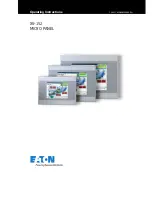
Making Measurements
Making Survey Measurements
4-22
Using the LI-6400
4
CO
2
Since photosynthesis is a function of CO
2
, it is important to have the chamber
CO
2
concentrations as consistent as possible.
If you do not have a CO
2
mixer, youÕll have to carry along a buffer volume
to dampen the potentially huge fluctuations in CO
2
that will occur should you
choose to breathe while you work. Buffer volumes are discussed in
on page 4-47. If you use a long tube
4
and a pole to draw
the ÒcleanÓ air from well above your head, you will still need a buffer volume,
albeit a smaller one might suffice. Whatever you use, experiment until you
have fairly steady reference CO
2
concentrations.
Life is much easier with a CO
2
mixer. You only need to decide whether to
control reference or sample CO
2
. If measurement speed is important, then by
all means control on reference. If you want near-ambient values in the sample
cell, set the reference for the right amount above ambient. Try a leaf or two
until you get it right. On the other hand, if you can afford 2 or 3 minutes per
measurement and want consistent sample CO
2
concentrations, try the S op-
tion (
f3
level 2).
Flow / Humidity
Use a fixed flow rate, medium or high, with little or no desiccant scrubbing.
HereÕs the rationale: Fixed flow rate minimizes the time for system equilibra-
tion, once a leaf is installed. Minimal scrubbing along with a high flow rate
means the chamber humidity will be reasonably close to ambient.
There are interactions with CO
2
control. If you are using the CO
2
mixer, the
soda lime must be on full scrub, and that usually means the incoming humid-
ity will be below ambient, even with the desiccant on full bypass. You can
moisten the soda lime (see
reduce the flow rate a bit to offset this.
Temperature
There are two schools of thought about temperature control and survey mea-
surements: one is that you shouldnÕt use the coolers so that your battery life
is maximized. The other says you should use the coolers to maintain ambient
temperature, so that the chamber doesnÕt get hot being in the sun. You decide.
4.
Make sure its inside diameter is
larger
than 1/8 inch, to avoid pressure drops
and reduced pump performance.
Summary of Contents for LI-6400
Page 1: ...Using the LI 6400 Portable Photosynthesis System ...
Page 15: ...Part I The Basics ...
Page 16: ......
Page 174: ...Making Measurements Answers to Questions 4 56 Using the LI 6400 4 ...
Page 175: ...Part II Useful Details ...
Page 176: ......
Page 200: ...Standard Tools Power ON Hooks 5 24 Using the LI 6400 5 ...
Page 214: ...Real Time Data Real Time Graphics 6 14 Using the LI 6400 6 ...
Page 234: ...Environmental Control Light Control 7 20 Using the LI 6400 7 ...
Page 244: ...Light Sensor Considerations Gallium Arsenide Phosphide GaAsP Sensor 8 10 Using the LI 6400 8 ...
Page 288: ...Data Logging Making Your Own AutoPrograms 9 44 Using the LI 6400 9 ...
Page 289: ...Part III Working With Files ...
Page 290: ......
Page 312: ...The LPL File System Troubleshooting 10 22 Using the LI 6400 10 ...
Page 340: ...Downloading Files Using a Data Capture Program 11 28 Using the LI 6400 11 ...
Page 375: ...Part IV Configuration Issues ...
Page 376: ......
Page 420: ...Defining User Variables Old Style vs New Style 15 18 Using the LI 6400 15 ...
Page 454: ...Using an Energy Balance Further Reading 17 12 Using the LI 6400 17 ...
Page 455: ...Part V Maintenance Troubleshooting ...
Page 456: ......
Page 572: ...Troubleshooting Useful Information 20 46 Using the LI 6400 20 ...
Page 593: ...Part VI Programming ...
Page 594: ......
Page 622: ...Programming with LPL Compiler Directives 22 28 Using the LI 6400 22 ...
Page 846: ...Index I 16 Using the LI 6400 ...
















































